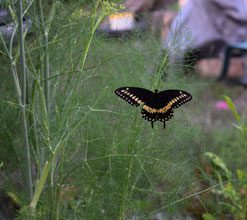 Like many another scion of Celtic forebears, I celebrate the arrival of the Winter Solstice; like many another gardener, I rejoice in the coming of the coldest, darkest days of the year. To be sure, I complain about the cold, lament the lack of sunlight, and crave the warm sunny days of summer still to come.
Like many another scion of Celtic forebears, I celebrate the arrival of the Winter Solstice; like many another gardener, I rejoice in the coming of the coldest, darkest days of the year. To be sure, I complain about the cold, lament the lack of sunlight, and crave the warm sunny days of summer still to come.
But midwinter’s chill has brought with it a time of repose and retrenchment in the garden and for many of its plants. For the gardener, as well.
At least that is how I have thought of the winter garden – I can take these months off, unconcerned with the daily care and work that the garden usually needs. However, the more I have come to know about plants, about the effects of temperature and sunlight, of moisture, of cycles of freeze and thaw, the more I have realized what amazing undercurrents of activity are taking place during this hibernation. And, perhaps even worse, I have come to see how much effect winter garden work can have on the vigor and health of the plants and the garden during the coming warmer, more obviously productive months. To my horror, I have realized that I don’t get time off!
This is heartbreaking for the lazy gardener.
There are welcome rewards, of course, in doing the real work the garden needs this time of year. The temperature now is a great deal more conducive to hard physical labor, like digging up plants, dividing them, digging more holes to receive the new plants. The garden grows by such means, and a great many plants benefit significantly from such dig-and-divide work. Our glorious Hemerocallis (daylilies), beautiful Iris, Coreopsis, Delphinium, Hosta – most clumping perennials eventually begin to choke themselves when the clump has grown too large to support its health. They will revive and grow much better if they are dug with lots of soil around the roots; cut apart into several smaller clumps of healthy, well-rooted plants; and planted again in new holes dug to fit the rootball. Our Lowcountry climate is wonderfully suited for encouraging the new plants to re-establish themselves with substantial below ground growth during these winter months, although they do usually appreciate an inch or two of mulch to help with the transition.
Winter can be a perfect time for doing some pruning work on trees and shrubs, many of which have gone dormant in the cold months. Avoid pruning azaleas and camellias until after they flower; but trees which have gone truly dormant, that have lost their leafy cover, give the gardener a clear view of the branch structure. This makes it much easier to identify damaged or diseased branches for immediate removal close to the trunk or main stem. Similarly, branches which cross over each other, branches which rub together, “water sprouts” – all these can be seen and removed. Some shape-improving pruning can be done as well. These Clemson horticulture pages give excellent information on pruning shrubs (http://www.clemson.edu/extension/hgic/plants/landscape/shrubs/hgic1053.html)
and pruning trees (http://www.clemson.edu/extension/hgic/plants/landscape/trees/hgic1003.html) .
Additionally, Clemson provides excellent information on pruning specific trees and shrubs, like roses, crape myrtles, pear trees, etc.
Inevitably someone asks with fervent anxiety, “When can I prune my hydrangeas?” The answer takes a bit of inquiry and explanation, however, and the questioner usually wants a one-sentence answer. Hydrangeas comprise several different types – species – of shrubs; removing old branches at the wrong time can make some of them bloom poorly.
The most popular hydrangeas in our gardens are the big-leaf hydrangeas with the big mop heads of pink, blue or purple flowers – Hydrangea macrophylla. After winter cold has left bare stems with dried brown remnants of last summer’s flowers, it is tempting to cut those stems back to the ground.
Don’t.
That would certainly encourage new growth from the ground in the spring, but on this species the flower buds form on old stems, not on new growth. It would be okay to prune to the ground perhaps one out every three stems – on my older hydrangeas, I do this every year. That way, the old plant is one-third-new every year, and the bloom isn’t hurt at all.
This method is also the one to use if you should need to prune one of the magnificent native hydrangeas, Hydrangea quercifolia – the gorgeous oakleaf hydrangea.
If you have an “Annabelle” hydrangea or one of its sisters – Hydrangea arborescens – you will find that the blooms come each year from the stems which grow that season. They bloom on new growth, which means they can indeed be pruned in the winter. In fact, if you cut them back after they start growing, you will be removing the new blooms. Many people will cut “Annabelle” and other H. arborescens nearly to the ground each winter. This doesn’t interfere with the blooming, but it may keep the stems from becoming strong thick stems; the big flower heads then flop over in the first good rain. Better to leave a foot or two or three of old stem when cutting back.
The handsome white “PeeGee” hydrangea, H. paniculata, is sometimes trained as a single trunked “tree”, although it makes a lovely shrub as well. “PeeGee” blooms on new growth, too, and can therefore be cut back when it is dormant. If, however, you cut back the central trunk, the “tree” will grow back as a shrub.
I should also add a couple of extra notes here, as well, about hydrangea pruning and blooming. Some newer types of mophead hydrangeas are genetically able to rebloom in a season. That is, they are able to bloom on old stems and on new growth, too. These, such as “Endless Summer”, are very forgiving of mistaken pruning.
Also, hydrangeas rarely actually need any pruning. Removing diseased or dead wood can be done any time, as can removing the old flowers at the very tip of the stem.
And if you screw up and prune out blooming stems accidentally, fear not. The plant will probably be just fine; it may even grow back more vigorously. You may miss a season of those enchanting flowers, but they, too, should return the following year.
These winter days – some of which, at least, have been cold – have been perfect for raking up some of the fallen leaves. I try to get them before the winds blow them across the road into the woods, where they do wonders for the forest trees but do nothing for my garden. The leaves are such wonderful mulch, I gather bags full from curbside collection to augment the leaves from my own trees.
One other enticement to do the winter work in the garden is the opportunity to appreciate the beauty of the camellias, which are in bloom from early fall into the spring. The variety of colors and patterns in the flowers of this ancient garden shrub is enough to make a day of raking beneath them a joyous undertaking… even for the lazy gardener.
So, I suppose the celebration of Solstice each winter and the acknowledgment of substantial tasks to perform even in the dormant garden are a kind of reminder of the whole cycle of the garden. The gardener’s role is never completed; there is always something needing attention; and at every turn there are rewards – joys, gifts – for the gardener that make it easier to get off one’s lazy behind. Most days, anyway.







